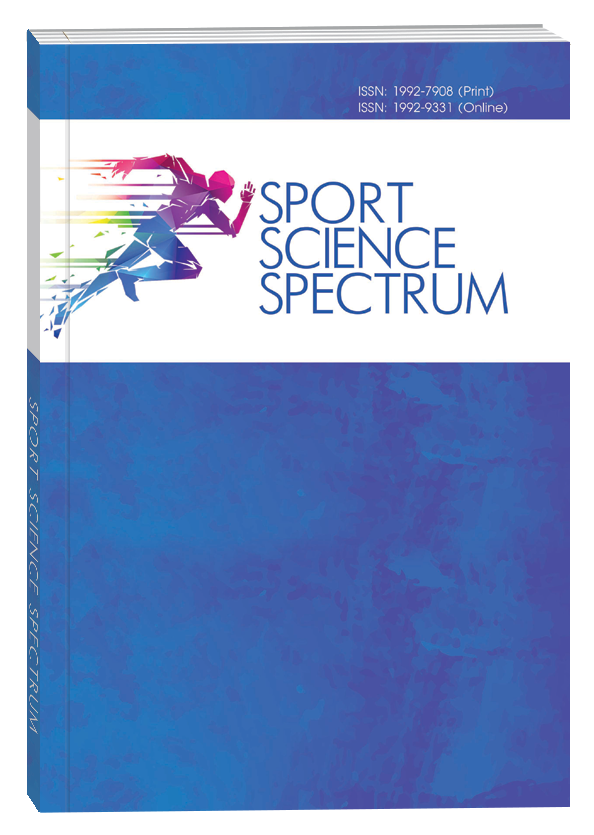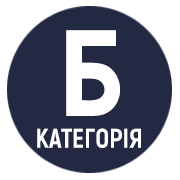EFFECTIVENESS OF MOVEMENT ACTIVITY IN THE PREVENTION OF STRESS-ASSOCIATED CONDITIONS IN HIGHER EDUCATION STUDENTS IN WARTIME
DOI:
https://doi.org/10.32782/spectrum/2024-3-1Keywords:
physical activity, students, stress-associated condition, influence, model, effect, adventure tourism, mental fitness, sports gamesAbstract
There is numerous evidence of the beneficial effect of movement activity on stress-associated conditions in higher education students (stress, anxiety and risk of PTSD). However, the question of which types of movement activity are optimal for them in wartime remains open. This research project is designed to fill the gap in scientific knowledge and identify the types of movement activity that may be most useful for higher education students in difficult wartime conditions. The aim is to assess the impact of different types of physical activity (adventure tourism, game sports and choreography with elements of mental fitness) on stress-associated states (stress, anxiety, risk of post-traumatic stress disorder (PTSD)) of Ukrainian students of higher education institutions (HEIs) in wartime conditions. Methods. The following methods were applied: sociological, psychodiagnostic research methods, methods of assessing physical activity, modeling and statistical analysis. Results. Statistically significant (p<0.05) models for predicting stress, anxiety and risk of PTSD in higher education students in wartime conditions were constructed. The anxiety prediction model demonstrated the lowest predictive ability. The following important predictors for predicting stress were found to be: the general assessment of the psychophysiological state of students and the number of their stress-associated states. It was established that the only model that included variables related to RA is the model for predicting the risk of PTSD in students. This same model also demonstrates the highest quality (R2=0.316; F=9.082; p<0.05). Conclusions. The study showed that the risk of developing PTSD in students depends on several factors, in particular the level of motor activity, the presence of harmful habits and participation in adventure tourism. Students with a higher level of motor activity and those who do not have harmful habits have a lower risk of developing PTSD, and adventure tourism enhances this effect. Research prospects. The results of the study will serve as a basis for developing practical recommendations on the use of various types of motor activity as an effective means of preventing stress-associated conditions of university students in wartime conditions.
References
1. Андрєєва О., Дутчак М., Благій О. Теоретичні засади оздоровчо-рекреаційної рухової активності різних груп населення. Теорія і методика фізичного виховання і спорту. 2020. № 2. С. 59–66. DOI: 10.32652/tmfvs.2020.2.59-66
2. Благій О.Л., Андрєєва О.В. Рухова активність як фактор формування здорового способу життя учнівської молоді. Актуальні проблеми фізичного виховання, реабілітації, спорту та туризму : Матеріали ІІІ-ї міжнар. наук.-практ. конф. Запоріжжя : КПУ, 2011. С. 27–28.
3. Марчик В.І. Вплив рухової активності на прояв стресу у студентів під час війни Навчання, виховання й розвиток гармонійно розвиненої особистості в процесі занять фізичною культурою і спортом : монографія / ред. В.М. Пристинський, Т.М. Пристинська. Слов’янськ : ДВНЗ «Донбаський державний педагогічний університет», 2023. С. 44–54.
4. Мороз Л.І., Сафін О.Д. Модель розвитку стресостійкості здобувачів вищої освіти в умовах воєнного стану. Вчені записки ТНУ імені В. І. Вернадського. Серія: Психологія. 2022. Т. 34 (73)/ № 5. С. 48–53.
5. Пальчук М.Б., Кенсицька І.Л. Трансформація сфери дозвілля студентської молоді в умовах сьогодення. Науковий часопис НПУ імені М. П. Драгоманова. 2021. Т. 2 (130). С. 95–97.
6. Ai X., Yang J., Lin Z. & Wan X. (2021) Mental Health and the Role of Physical Activity During the COVID-19 Pandemic. Front. Psychol. 12:759987. doi: 10.3389/fpsyg.2021.759987
7. Andrieieva O., Byshevets N., Kashuba V., Hakman A., & Grygus I. (2023). Changes in physical activity indicators of Ukrainian students in the conditions of distance education. Fizicna Reabilitacia ta Rekreacijno-Ozdorovci Tehnologii, 8(2), 75–81.
8. Browning M.H. E.M., Larson L.R., Sharaievska I., Rigolon A., McAnirlin O., Mullenbach L., Cloutier S., Vu T.M., Thomsen J., Reigner N., Metcalf E.C., D’Antonio A., Helbich M., Bratman G.N., Alvarez H.O. (2021). Psychological impacts from COVID-19 among university students: Risk factors across seven states in the United States. PLoS ONE, 16(1), Article e0245327. https://doi.org/10.1371/journal.pone.0245327
9. Byshevets N., Andrieieva O., Dutchak M., Goncharova N. (2024). The influence of physical activity on stress-associated conditions in higher education students. Physical Education Theory and Methodology, 24(2), 245–253. https://doi.org/10.17309/tmfv.2024.2.08
10. Byshevets N., Andrieieva O., Goncharova N., & Dutchak M. (2023). Prediction of stress-related conditions in students and their prevention through health-enhancing recreational physical activity. Journal of Physical Education and Sport, 23(4), 937–943. https://doi.org/10.7752/jpes.2023.11339
11. Byshevets N., Andrieieva O., Pasichniak L., & Goncharova N. (2024). Evaluation of emotional disorder risk in students with low physical activity levels under stressful conditions. Journal of Physical Education and Sport, 24(4), 894–904. https://doi.org/10.7752/jpes.2024.04102
12. Byshevets N., Goncharova N., Serhiienko K., & Dutchak M. (2022). Peculiarities of behavior and reactions of students of higher education in physical culture and sports under the influence of crisis phenomena. Scientific Journal of M. P. Dragomanov National Pedagogical University, 8(153), 21–25. https://doi.org/10.31392/NPU-nc.series15.2022.8(153).05
13. Dahlstrand J., Friberg P., Fridolfsson J., Börjesson M., Arvidsson D., Ekblom Ö., Chen Y. (2021). The use of coping strategies «shift-persist» mediates associations between physical activity and mental health problems in adolescents: A cross-sectional study. BMC Public Health, 21(1), 1104. https://doi.org/10.1186/s12889-021-11158-0
14. Han S.S., Li B., Ke Y.Z., Wang G.X. (2022). Chinese college students’ physical-exercise behavior, negative emotions, and their correlation during the COVID-19 outbreak. International Journal of Environmental Research and Public Health, 19(16), 10344. https://doi.org/10.3390/ijerph191610344
15. Kraskov O. (2024). The Impact of Stress Factors Related to the War in Ukraine on the Mental Health of Young People (A Case Study of 3-4 Year Old Students at the National University of Kyiv-Mohyla Academy). Psychosomatic Medicine and General Practice, 9(3). https://doi.org/10.26766/pmgp.v9i3.522
16. Kumar S., & Bhukar J. (2013). Stress level and coping strategies of college students. Journal of Physical Education and Sport Management, 4(1), 5–11.
17. Kurapov A., Pavlenko V., Drozdov A., Bezliudna V., Reznik A., Isralowitz R. (2023). Toward an understanding of the Russian-Ukrainian war impact on university students and personnel. Journal of Loss and Trauma, 28(2), 167–174. https://doi.org/10.1080/15325024.2022.2084838
18. Onieva-Zafra M. D., Fernández-Muñoz J. J., Fernández-Martínez E., García-Sánchez F. J., Abreu-Sánchez A., Parra-Fernández M. L. (2020). Anxiety, perceived stress, and coping strategies in nursing students: A cross-sectional, correlational, descriptive study. BMC Medical Education, 20(1), 370. https://doi.org/10.1186/s12909-020-02294-z
19. Pascoe M. C., Hetrick S. E., Parker A. G. (2020). The impact of stress on students in secondary school and higher education. International Journal of Adolescence and Youth, 25(1), 104–112. https://doi.org/10.1080/02673843.2019.1596823
20. Pavlova I., & Rogowska A. M. (2023). Exposure to war, war nightmares, insomnia, and war-related posttraumatic stress disorder: A network analysis among university students during the war in Ukraine. J Affect Disord. 342, 148–156. https://doi.org/10.1016/j.jad.2023.09.003
21. Pavlova I., Rogowska A. M., Zhang S. X. (2023). Mental health and well-being during the COVID-19 pandemic and after the Russian invasion of Ukraine. Journal of Community Health. https://doi.org/10.1007/s10900-023-01273-x
22. Shpakou A., Klimatckaia L., Skoblina N., Baj-korpak J., Skarbalienė A., Fedorciv O., Krestyaninova T., Znatnova A., Kuzniatsou A., Cherkasova J. (2021). The prevalence of loneliness among university students from five European countries during the COVID-19 pandemic. Psychology. Journal of the Higher School of Economics, 18(4), 871–887. https://doi.org/10.17323/1813-8918-2021-4-871-887





